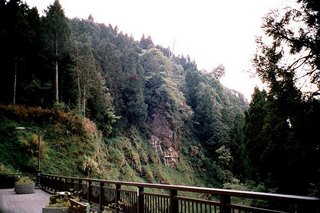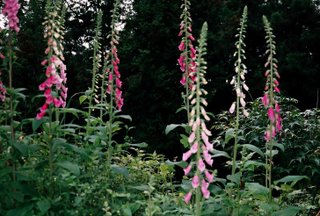Alishan 阿里山風景區

Alishan mountain range is in the west of Yushan 玉山range. Separated by Nansingxian stream, it faces Yushan. In the north is Nantou, the southern tip reaches Kaoshiong Jiguanshan. The whole range is North, northeast – south south west, 250 km long. On average 2200 m, the highest peak is Datashan大塔山.
The upside down U shaped range, funnel in the west southerly trade wind during the summer. On average the summer temperature is 18.8 degree Celsius. In May, June, it’s the rainy season, Jul, Aug, typhoon season, so the rainfall in these months is 70% of the annual rainfall. Rainfall days are 209 days. During autumn, winter, northeasterly trade wind brings more rain but also brings a lot of cloud, giving the cloud seascape.
From Chiayi city, at an elevation of 30 m above sea level, climb up to 2600 m, the forest range from subtropical, temperate to alpine zones. Subtropical zone consisted of figs, bethel nuts, bamboos and longans. At zhaoping, chiyunshi, are broad-leaved, pine needles and dominated by artificially planted Cryptomeria forests. Further up to zhushan, are Cryptomerias 柳杉, hemlock spruces 鐵杉, pine, mixed needle-leaved forests.
Alishan can be reached by car in two hours. There are also public buses at Chiayi which leaves at 630 am or 2 pm for Alishan. The most memorable one of course is the Alishan rail. It is one of three mountain railway in the world, the other two being found in India (Darjeeling-Himalaya Railway) and Peru (Andean Central Railway). It ascends up the mountain in its unique switch back method. The Alishan railroad was built by the Japanese from 1906-1913. The reason was timber. Three-thousand year-old cypress trees with girths of ? The trees were cut and transported by rail down to Chiayi and later shipped to Japan. Most of the old trees are no longer seen but a few are left and they can be seen along the giant tree trail boardwalk. At the shenmu station before Alishan station, there is an old tree trunk lying by the side of the railway track. It was called the sacred tree. It was upright till Jul 1 1997. Many of the old postcards or pictures will show this tree trunk leaning towards the railway track when it was still standing. The trees that visitors see are from reforestation work done by the Taiwanese after the Japanese occupation.
Initially the train was powered by steam, later diesel. Along the way, one can see lots of Bethel nut palm trees all over the mountainside. The whole length of the railroad is 71.35 km. Starting from 30 m above sea level at Chiayi to 2216 m. It has to pass through 50 tunnels and 80 bridges. Some of the stops along the way are worth stopping and visiting, such as Jiaoliping, Fenchihu. Zuqi station is built completely of the timber of Alishan. Zhangnaoliao station onwards was the most difficult stretch of rail to build. The story was that the Japanese engineer in charge of the project was stuck in how to build the rail along that steep part. One day, as he took a rest and ate his lunch, he saw a snail crawling by him. He got his inspiration from the snail shell’s spiral whorls. So if you look at the back of your train ticket, you can see how the rail spirals before straightening and then it went zigzag. The zigzag part was when the train switch rail to go up another stretch of the hill. As the train first left Chiayi, the train engine was pushing from the back of the train. At the zigzag part, the train is being pulled when it switched track. So first you go forward, then backward and then forward again until Alishan station where the train terminates.
One of Alishan’s famous produces is wasabe, the Japanese mustard. It was introduced from Japan to Alishan. The wasabe is a perennial herb, belonging to the Brassicaceae family. It prefers to grow in high altitude areas, cool wet and shady places. As the plant grows slowly, the price of wasabe is high. Those found in the market in the less expensive restaurants are artificial, or are made of horse radish.
For the naturalist, bird watching, flowers, giant trees, insects are a great draw. A few of the trees like Elephant nose tree, three-generation tree were thousand year old. The museum was closed when we went, it supposedly have collections of plant and animal specimens, mountain models, and cultural items. There’s also a Botanic pathway, very much derelict, with small signs giving the identity of the trees.
 Everywhere one goes, one cannot miss the Digitalis herb, downward pointing bell-shaped flowers in chains rising up from the ground with the leaves converging at the base. The flowers are colourful, pink, purple, white or yellow. They produce copious amounts of nectar thus they compete with local plants for pollinators. Although the plants are beautiful, introduced by the Japanese from Europe, they are extremely poisonous so nothing can eat them. They are flourishing all over Alishan, posing an ecological hazard.
Everywhere one goes, one cannot miss the Digitalis herb, downward pointing bell-shaped flowers in chains rising up from the ground with the leaves converging at the base. The flowers are colourful, pink, purple, white or yellow. They produce copious amounts of nectar thus they compete with local plants for pollinators. Although the plants are beautiful, introduced by the Japanese from Europe, they are extremely poisonous so nothing can eat them. They are flourishing all over Alishan, posing an ecological hazard.One of the nicest views of Alishan is the sisters’ lake. The lake waters are very clear. A shady hut is right in the middle of the lake. The view of the hut over the lake changes with the seasons. The nicest one was a picture I saw in a restaurant when the whole place was covered with snow.
Zhaoping station was where the old station used to be. Now, it carries passengers up to the Zhushan to view the sunrise. Tourists staying in Alishan Gou hotel are within walking distance to the station. The disadvantages of staying so near the railway station are the noise from the crowds waiting to board the train and the whistles from the train. One can also easily walk up to see the sunrise although a torch may be needed. However, the best way to savour the giant tree forest is the walk down after seeing the sunrise.

<< Home